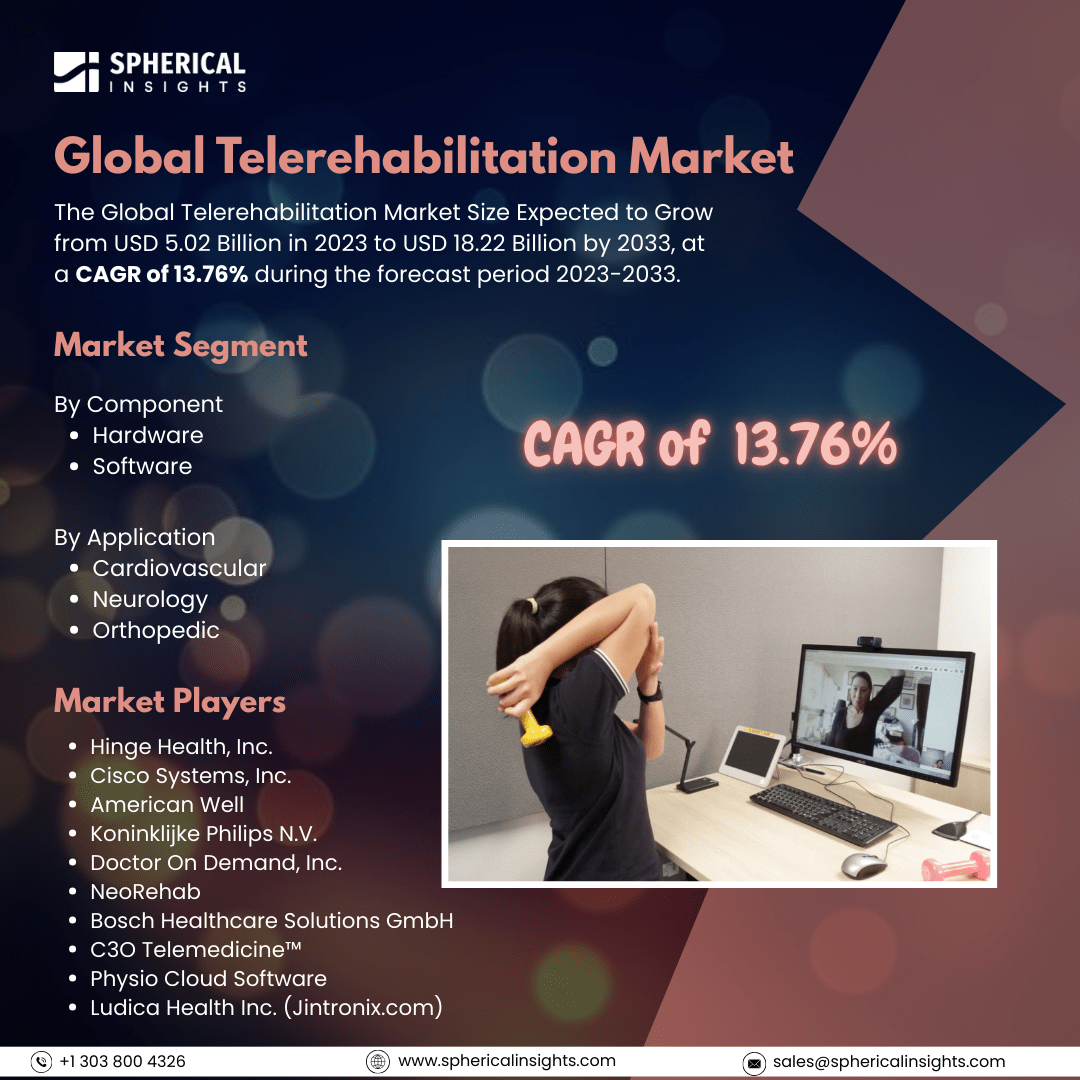Global Telerehabilitation Market Size to Exceed USD 18.22 Billion by 2033
According to a research report published by Spherical Insights & Consulting, The Global Telerehabilitation Market Size Expected to Grow from USD 5.02 Billion in 2023 to USD 18.22 Billion by 2033, at a CAGR of 13.76% during the forecast period 2023-2033.
Browse 210 market data Tables and 45 Figures spread through 190 Pages and in-depth TOC on the Global Telerehabilitation Market Size, Share, and COVID-19 Impact Analysis, By Component (Hardware and Software), By Application (Cardiovascular, Neurology, and Orthopedic), and By Region (North America, Europe, Asia Pacific, Latin America, Middle East, and Africa), Analysis and Forecast 2023 – 2033
The telerehabilitation market description is the market dedicated to telerehabilitation services with digital technology for remote therapy and medical consultation by patients under telecommunication platforms. It comprises virtual physical therapy, occupational therapy, speech therapy, and cognitive rehabilitation, assisting patients in recovery from injury, surgery, neurological illnesses, and chronic diseases. Moreover, the telerehabilitation industry is driven by rising demand for telemedicine, the growth in telehealth and AI-based rehabilitation, and chronic disease and demographic bulge. After COVID-19, there has been rapid acceptance of virtual therapy. Increased internet penetration, wearable health technologies, cost benefits, and the government's policies favoring telemedicine also spur market growth. However, major constraints are limited patient access to digital infrastructure, data privacy issues, regulatory problems, and the absence of reimbursement policies. Opposition from conventional healthcare providers and specialized training requirements also slow down market growth.
The software segment accounted for the largest share of the global telerehabilitation market in 2023 and is anticipated to grow at a significant CAGR during the forecast period.
Based on component, the global telerehabilitation market is divided into hardware and software. Among these, the software segment accounted for the largest share of the global telerehabilitation market in 2023 and is anticipated to grow at a significant CAGR during the forecast period. Major constraints are limited patient access to digital infrastructure, data privacy issues, regulatory problems, and the absence of reimbursement policies. Opposition from conventional healthcare providers and specialized training requirements also slow down market growth.
The neurology segment accounted for a substantial share of the global telerehabilitation market in 2023 and is anticipated to grow at a rapid pace during the projected period.
On the basis of the application, the global telerehabilitation market is divided into cardiovascular, neurology, and orthopedic. Among these, the neurology segment accounted for a substantial share of the global Telerehabilitation market in 2023 and is anticipated to grow at a rapid pace during the projected period. The growing incidence of stroke, Parkinson's disease, and traumatic brain injury fuels the demand for remote neurological rehabilitation. Improvements in AI, virtual reality (VR)-based therapy, and remote patient monitoring also improve treatment efficacy, positioning neurology as a prominent segment in the market.
North America is projected to hold the largest share of the global telerehabilitation market over the projected period.
North America is projected to hold the largest share of the global telerehabilitation market over the projected period. This is driven by sophisticated healthcare infrastructure, telehealth solutions high adoption, and high rates of chronic diseases. Support from the government, robust internet penetration, and the availability of prominent market players further enhance regional dominance and establish North America as the leading telerehabilitation services market.
Asia Pacific is expected to grow at the fastest CAGR of the global telerehabilitation market during the projected period. This is driven by sophisticated healthcare infrastructure, telehealth solution high adoption, and high rates of chronic diseases. Support from the government, robust internet penetration, and the availability of prominent market players further enhance regional dominance and establish North America as the leading telerehabilitation services market.
Company Profiling
Major vendors in the global telerehabilitation market are Hinge Health, Inc., Cisco Systems, Inc., American Well, Koninklijke Philips N.V, Doctor On Demand, Inc., NeoRehab, Bosch Healthcare Solutions GmbH, C3O TelemedicineTM, Physio Cloud Software, Ludica Health Inc. (Jintronix.com)., and others.
Key Target Audience
- Market Players
- Investors
- End-users
- Government Authorities
- Consulting and Research Firm
- Venture capitalists
- Value-Added Resellers (VARs)
Recent Development
- In July 2024, in order to facilitate access to their telehealth appointments for physiotherapy, the Federation Physiotherapy Virtual Care Clinic (FPVCC) established the first satellite hubs throughout the Latrobe Valley.
Market Segment
This study forecasts revenue at global, regional, and country levels from 2023 to 2033. Spherical Insights has segmented the global telerehabilitation market based on the below-mentioned segments:
Global Telerehabilitation Market, By Component
Global Telerehabilitation Market, By Application
- Cardiovascular
- Neurology
- Orthopedic
Global Telerehabilitation Market, By Regional
- North America
- Europe
- Germany
- UK
- France
- Italy
- Spain
- Russia
- Rest of Europe
- Asia Pacific
- China
- Japan
- India
- South Korea
- Australia
- Rest of Asia Pacific
- South America
- Brazil
- Argentina
- Rest of South America
- Middle East & Africa
- UAE
- Saudi Arabia
- Qatar
- South Africa
- Rest of the Middle East & Africa



